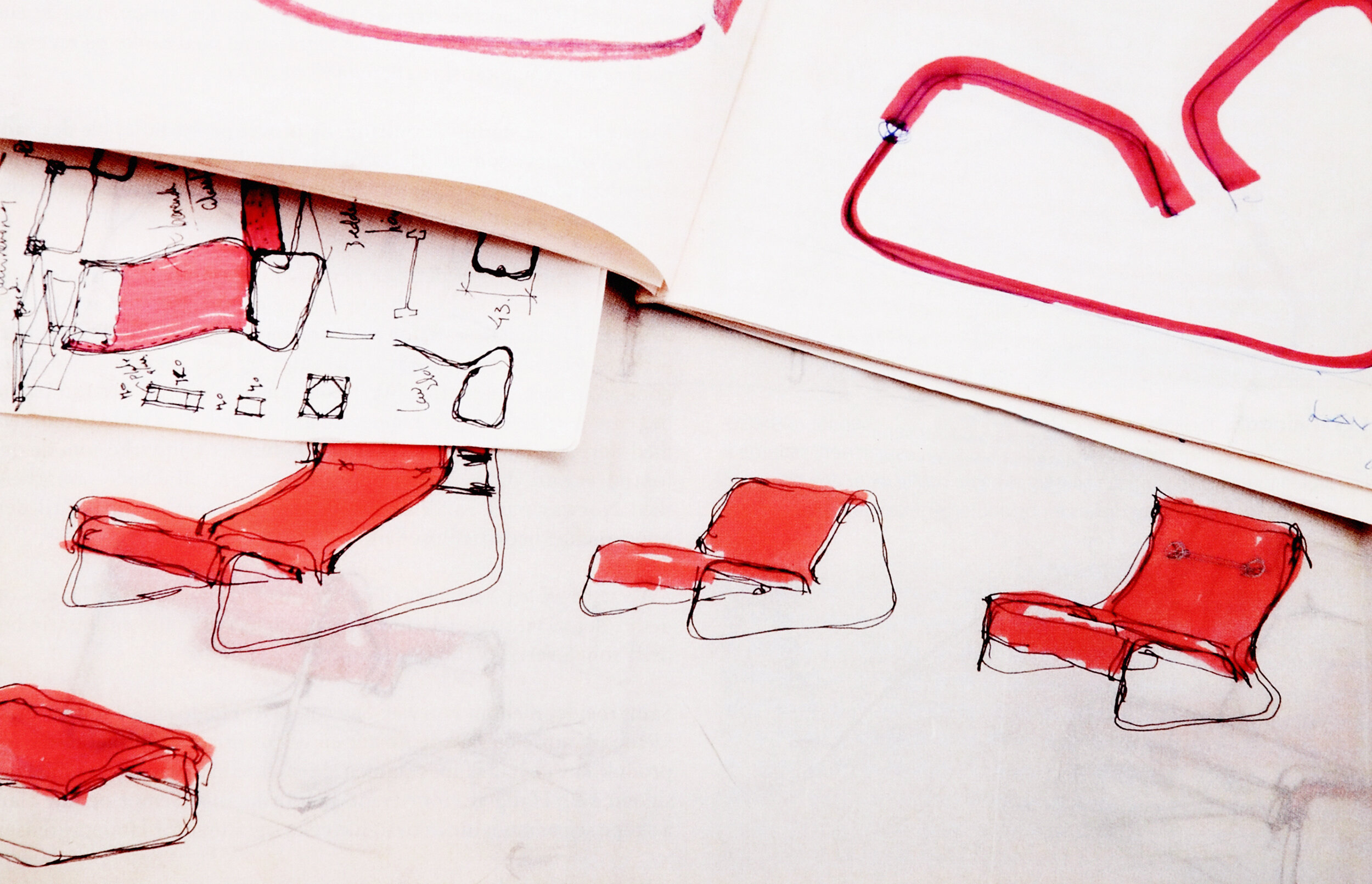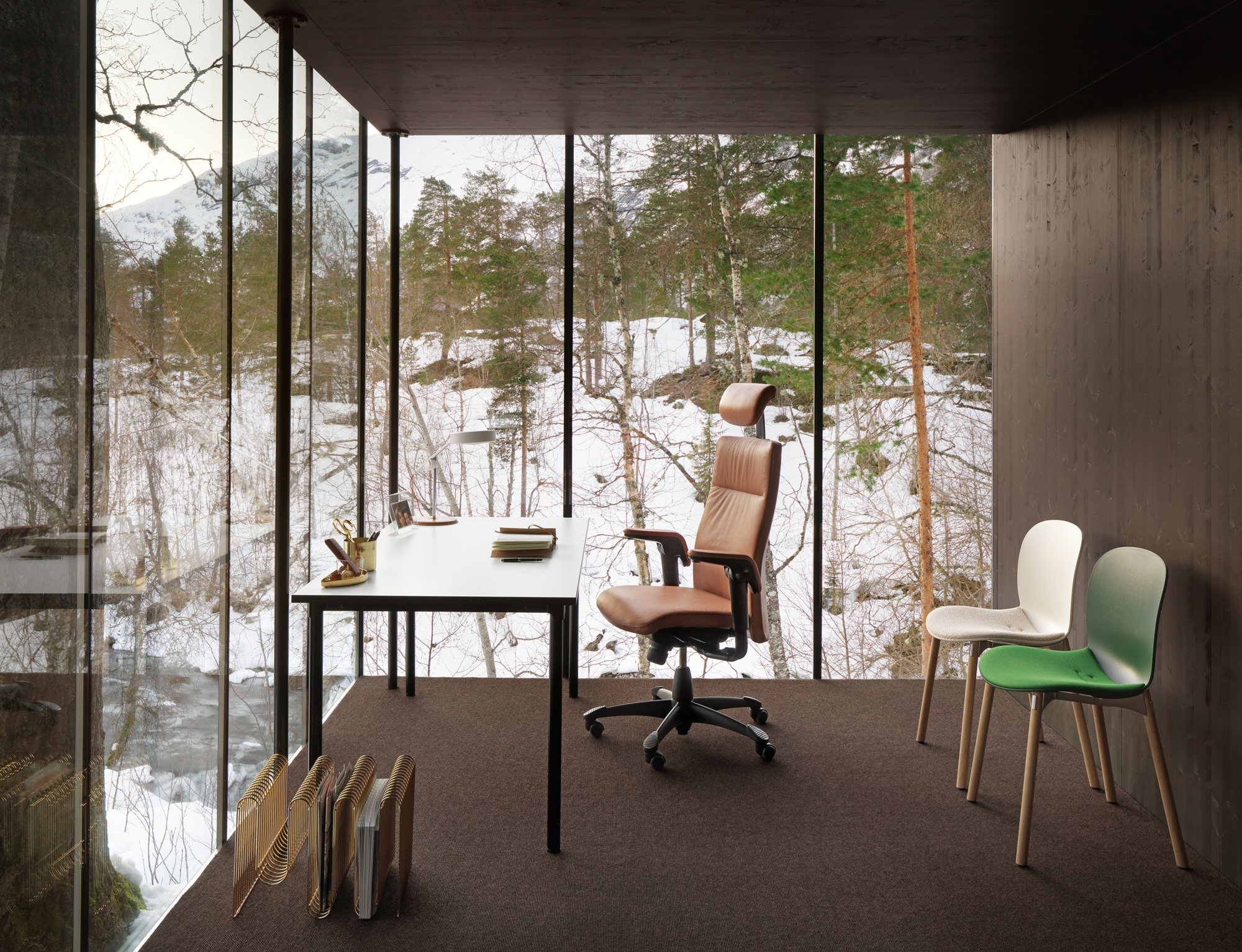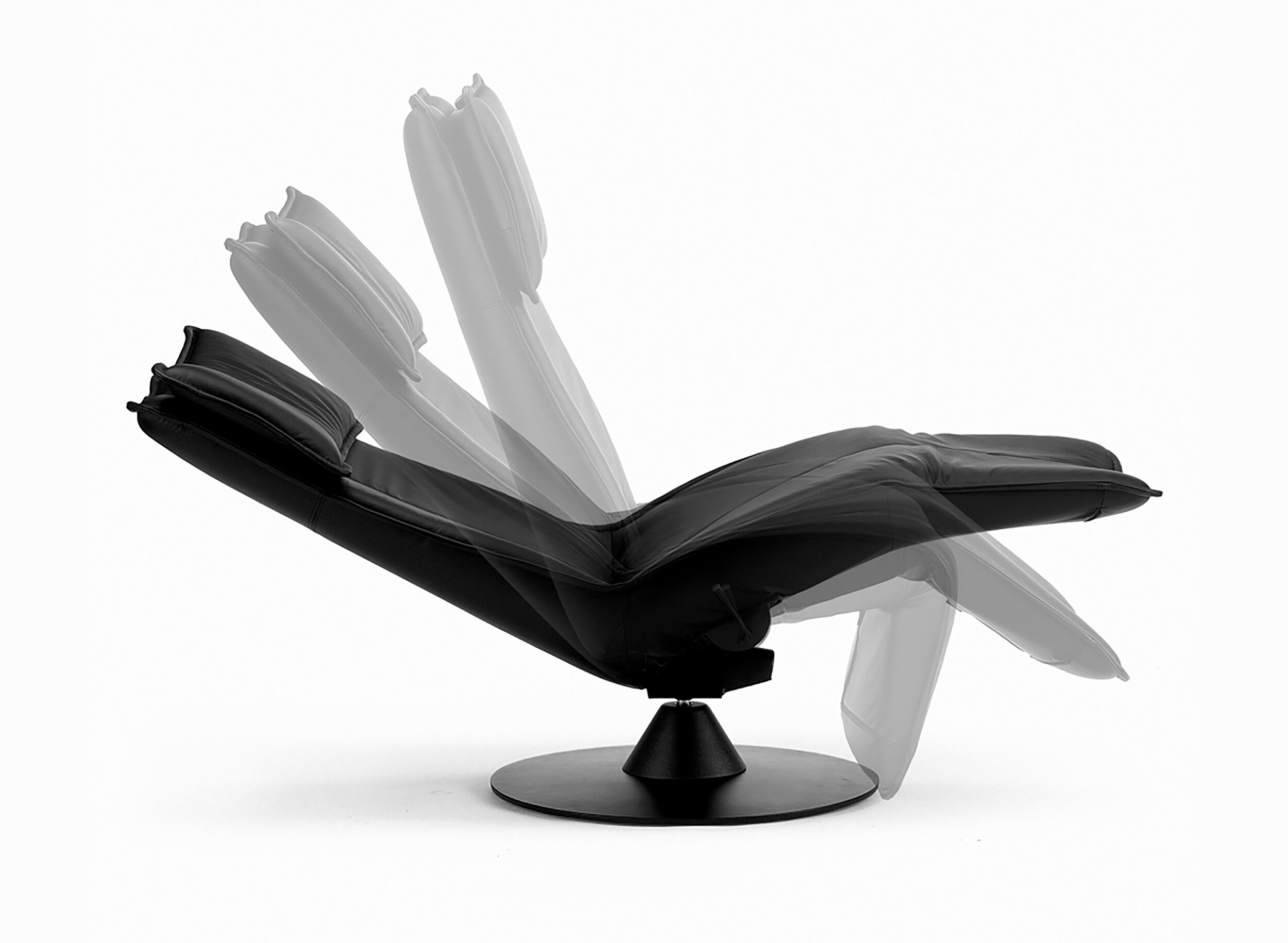The Story of sapDesign
Svein Asbjørnsen, born in Sykkylven on Sunnmøre, grew up with a father who ran a furniture factory at home in Knutgarden between 1943 and 1960. Svein took an early interest in furniture production and design, and after working in the local industry and vocational training in furniture at Borgund Vocational School, he completed the furniture design education at the Statens Håndverks– og Kunstindustriskole (SHKS) in Oslo from 1963—1967 with a diploma. During the summer holidays, he worked at Ingmar Relling's design office in Sykkylven, and in 1969 he was among the first to receive the industry association's scholarship for young, promising designers.
Møre Designteam 1970—1978
«Møre Designteam is a design group that was established in 1970 as a fresh addition to the Norwegian furniture industry. They broke with the current Scandinavian tradition and distinguished themselves with visionary furniture solutions — nationally and internationally.»
Mads Linder,
Visual artist, author and writer
Møre Designteam (MD) was founded by the interior architects (MNIL) Svein Asbjørnsen, Jan Lade and Svein Leirdal in 1970. Asbjørnsen and Leirdal were fellow students from SHKS (1968) in Oslo, Lade came from the School of Arts and Crafts (1969) in Copenhagen. All of their fathers had engaged in furniture production, and they had also grown up on a farm and were used to challenges.
MD got a contract with the local upholstered furniture manufacturers L.K.Hjelle AS, Hjellegjerdes Lenestolfabrikk AS and Hole & Lillebøe AS, which made it easier to get started. In addition to product development, they made solutions for exhibition architecture, and assisted with photo styling and brochures. They created international exhibitions for the companies' export company Norfact and Scandia Furniture. In 1973, Norbert Hovet joined as a graphic designer, but under his own company Møre Designteam Advertisement.
MD entered the traditional furniture market on the factories' own terms and created a number of best selling products that secured their jobs and finances in a difficult time: salons, modules and laminated chairs. Møre Designteam's Colombi Salon was produced by Hjellegjerde Møbelfabrikk AS, and was the first of several successful models for the factory. The rational system of stingrays was adopted by many factories and is still alive, 50 years later.
The same simplification was done in the model «1001» for Hole & Lillebøe AS. This was one of the first modular sofas in Scandinavia. The modular furniture gave the user the opportunity to compose their own sofas, from one–seater to two-seater and with varied seat depth. The molds for model 1001 became the first cold foam project with cast–in reinforcement for the manufacturer Sandella.
The young designers of MD sought professional challenges by participating in design competitions advertised by the furniture associations in the Nordic countries. They got a flying start when they won 1st prize in the Norwegian Industry Council's furniture competition in 1971 with the concept Ecco for L.K.Hjelle. In addition their Z chair received a purchasing award. Both models had resilient shapes that received international attention from major European and American companies, as well as furniture magazines that came to visit, and the young team was put on the international designer map.
Another important concept in the 1970s was the development of the Stressless concept, with models Stressless Global and Stressless Original, which MD brought forth on behalf of Jens E. Ekornes, based on his vision of a movable TV chair. The chairs were launched at Sjølystmessa in 1971. The furniture museum in Sykkylven marked Stressless' 50th anniversary with a large exhibition in 2021. The concept is still alive and well with the sliding solutions designed by Møre Designteam trio Svein Leirdal, Jan Lade and Svein Asbjørnsen in 1970.
After a very active period, Leirdal had to quit in 1975 to take over his father's furniture business, but he joined the team in the Nordic Furniture Competition in 1976. As finalists, MD exhibited at the Bella Center in Copenhagen and again received the 1st prize for People Are Different, a compact living system. The basic idea was that all people are different and that different age groups have different needs. Based on analyzes, Møre Designteam developed a sofa system with seating and sleeping areas for families in small areas. Leirdal was replaced by furniture designer and interior architect MNIL Olav Eldøy who had good two years in MD, and became a recognized designer in the industry.
Møre Designteam became an important environment for the design industry in Norway. The art academies in Oslo and Bergen who visited the furniture companies in the region annually, always stopped by the designteam MD. The directors of the various manufacturers in the region also visited MD regularly to gather inspiration and share ideas. In addition, they were constantly approached by agents who offered their goods, and contributed to an updated knowledge base.
Asbjørnsen & Lade AS 1978—1989
The designers changed their name to Asbjørnsen & Lade AS in 1978. At this time, the company had its own model workshop, and Arve Grønmo came in as a model carpenter (1978). Until then, Grønmo had been foreman and product developer for LK Hjelle. Egil Maalø was also hired, he was an interior architect NIL educated at the School of Arts and Crafts in Oslo in 1979, he also had a master's degree in upholstery that fit well. Collaborating factories established Sykkylven Industrier in 1979, which targeted the public market, hotels in particular. Asbjørnsen & Lade created new design solutions, and interior architect NIL Pål Hjelle was hired for the special field of hotel interior design. Together, they created several interiors for the hotel and restaurant market throughout the country, and developed products for the company Sicon. They decorated for Union Hotell in Geiranger, for their new opening in 1981, as well as Alexandra Hotell in Loen.
Asbjørnsen & Lade continued to look for other ways of furnishing the living room, alternatives to the traditional sofa group. One of the motives was how to combine active and passive use — work and rest, with family gatherings. Another was flexible seating, seating with adjustable neck and back cushions, called Split, after the marked split in the back. This concept was completely new to the market. It came with sleeping and seating areas for homes and home offices, with integrated light sources and smart table solutions. During participation in the Nordic Industry Council's Design Competition in Copenhagen in 1979, the concept won first prize.
The Japanese manufacturer Hakuju showed interest, and wanted to use the Split concept in a health program. This led to a long time collaboration, firstly with Italian, and then Norwegian production at Vestlandske Møbler AS in Sykkylven. The award–winning Split concept also resulted in a production contract with Ekornes ASA. The Split Collection had tall backs with the characteristic split in the middle, and came with functional table solutions in different variants. The brand name Adlibitum was also used on this collection.
Asbjørnsen & Lade started collaborating with Håg AS (now Flokk AB), which took out a world patent for the Split concept for offices, working environment, health and transport. This started off a 40 year long collaboration around groundbreaking, exclusive office chairs.
Together with several design colleagues who worked for HÅG, Asbjørnsen & Lade organized and built the exhibition "Studio HÅG" in 1984 at the furniture fair in Copenhagen. It was creatively presented by a pantomime artist, and received great international attention. A variant of the exhibition was Chairytale from Norway, exhibited at Earls Court in London in collaboration with designer and professor Svein Gusrud. The Split concept was further on exhibited through the summer at Vognremissen in Oslo, and elected a representative of NIL during Sjølystmessen the same year. Håg AS also established the company Mobilitet, which presented its products to the international transport industry. The Split concept was further developed and presented to e.g. SAS, Amtrak and NSB, which led to several development projects carried out by Asbjørnsen & Lade. The Split patent as a base for sound absorbing technology was also established together with a development environment in Cambridge, and became the first step towards todays sound canceling earphones. A curiosity is that the first slidable and flippable neck pillows, which are to be found in all planes and train seats around the world, were created here.
In 1989, Håg and Asbjørnsen & Lade launched the new office chair Signet, as well as the conference chair Air. Signet received the Mark for Good Design in 1991, the Best in Show and Gold Award in Neocon, Chicago in 1993 and the Certificate of Excellence in Montreal in 1994. The series gained a large, international market until 2004, when it was replaced by sapDesign's HÅG H09 collection . In 2009, this series also received the Mark for Good Design, and was nominated for the Honorary Award the same year. In 2009, HÅG H09 received the new Design Effekt award.
H09 Privacy
sapDesign AS 1989 —
In the autumn of 1989, Jan Lade left Asbjørnsen & Lade AS. The company was dissolved and a new company established as sapDesign AS with Svein Asbjørnsen as the main shareholder. Later, Egil Maalø and Arve Grønmo also joined as shareholders, and Ingjerd Asbjørnsen was hired as mercantile leader. sapDesign continued its collaboration with HÅG AS with the development of exclusive, functional office chairs.
Tribute. The Split patent from 1980, being the backbone of the company’s viability, was again launched by Flokk AB (Håg AS) in 2017, in the model Tribute. Now in a covered up solution, with height adjustment of the lumbar cushion by a steering wheel on the back. This solution was also given the patent automatic shoulder / neck extension, which provides a unique sitting experience when reclining and contemplating work. The H09 series and «H09 Tribute» point forward as long lasting, classic solutions on functional and environmentally sustainable products.
H09 Tribute
Contura. During the work process for Håg Mobilitet AS, on a project for Scandinavian Airlines focusing on lounge chairs adapted for overseas flights, a new idea arose, and grew into what became the SapDesigns Contura Collection. The Contura reclining chair, with feet above the heart, also included the Split concept with a patented closed solution. In collaboration with Vestlandske Møbelfabrikk / Westnofa, Contura was launched during the Cologne Fair in 1994. Since then, the Contura has been produced and sold in Europe and Scandinavia by various furniture manufacturers, and is now also under development and production at Chinese Castlemark Co. Ltd. under the name Convita.
Oasis/Quiet Pod. In 1998, SapDesign participated in an international design competition in Osaka, Japan with the concept Oasis. A quiet space for urban areas where large crowds gather and need a break from physical and acoustic noise. The idea was picked up by Erlend Einarsen, who had his own ideas for shielding mobile phone calls, and formed the company Quietpod AS. Since entering into an agreement in 2002, the company has further developed the concept together with sapDesign as and designer Jarle Slyngstad, sound shielding, movable room-in-rooms for rest, work, conference and phonecalls. The concept is perfect for office landscapes, factories, lobbies, schools and public areas where people meet, and is now on sale through the newly established company Quietpod Scandinavia as.
Tilter® As a young student back in 1965, Svein Asbjørnsen had solved his work chair task with something completely new. In order for the chair to follow the body's natural need for movement, he created a vulcanized rubber block, which released the chair's seat surface from its base and back, eliminating pressure on thighs and back. He molded the idea through many years, and in 1990 it was patented under the name Tilter®. It was then implemented in the lounge and conference chair Communication, together with the patent "Resilient joints" on the same philosophy, which was used in HÅG's conference chair Air and the office chair Signét. The patent was entered into an agreement with the Danish company Betech as, which has a WW agreement and from 2013 had continuous production on the fittings.
Art. As an independent artist, Svein Asbjørnsen created the decoration for the dance and conference halls of Union Hotell Geiranger in the interior design project in 1979, inspired by the mighty nature in the area. In 1998—90, he designed and coordinated the furniture and interior components for Sykkylven's new church, together with Jan Lade, Arve Grønmo and Egil Maalø. Through the model workshop, Arve Grønmo coordinated the production carried out by the furniture craftsmen in Sykkylven. A few years later Asbjørnsen created the altarpiece and chairs for the church chapel. Metal artist Kjell Gunnar Overøye executed the metal construction, and shaped the crucifix according to Asbjørnsen's idea. He was also central in the coordination of Church Art.
Berlihuset. In 1986, Asbjørnsen & Lade AS bought the historic patrician villa Berlihuset on Klokkehaug in Sykkylven (1896). Asbjørnsen & Lade put great effort and resources into restoring the building and maintaining the property. Their first tenant, Norsk Møbelfaglige Senter, moved in in 1994. In 1996, Asbjørnsen was awarded the Past Memory Association's Good Protection Prize. Berlihuset is still owned by sapDesign as.
Tynes factory. Today, SapDesign has its offices in the Tynes factory in Sykkylven, built in 1931 by founder B. R. Tynes. SapDesign and designer Jarle Slyngstad established their offices and the workshop PU Fabrikken, which works with prototypes, zero series, special furnishings and furniture renovation for customers both locally and nationally. Product developer Arve Grønmo has led and operated the company's model workshop since 1976. The PU Factory is now led by product developer Reno Egseth, who is also a co-owner.
COPYRIGHT NOTE
All efforts have been made to identify the copyright holders, yet this was not possible for several items. To provide this information, please contact us — and we will make sure to ad this to our site. Thank you!





















